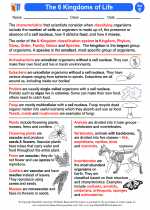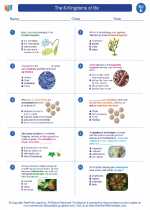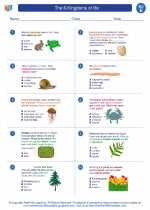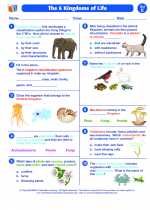The 6-Kingdoms of life -> oceans
Oceans
Oceans are large bodies of saltwater that cover over 70% of the Earth's surface. They play a crucial role in regulating the planet's climate, providing a habitat for a wide variety of marine life, and supporting the livelihoods of millions of people around the world.
Ocean Features
- Continental Shelf: The shallow, submerged edge of a continent.
- Mid-Ocean Ridge: Underwater mountain range where new oceanic crust is formed.
- Trenches: Deep, narrow depressions in the ocean floor, typically formed at plate boundaries.
- Seamounts: Underwater mountains that do not reach the ocean surface.
Ocean Zones
The ocean can be divided into several distinct zones based on depth and light penetration:
- Epipelagic Zone: The top layer of the ocean where most marine life resides.
- Mesopelagic Zone: Also known as the twilight zone, where sunlight is minimal.
- Bathypelagic Zone: The deep ocean, where sunlight does not penetrate.
- Abyssopelagic Zone: The abyssal plains and trenches, characterized by high pressure and low temperatures.
Ocean Currents
Ocean currents are continuous, directed movements of seawater generated by a combination of factors, including wind, temperature, the Earth's rotation, and tides. They play a critical role in regulating global climate and redistributing heat around the planet.
Human Impact on Oceans
Human activities, such as overfishing, pollution, and climate change, have significantly impacted the health of the world's oceans. It's essential for us to take steps to protect and preserve this vital resource for future generations.
Study Guide Questions
- What percentage of the Earth's surface is covered by oceans?
- Describe the different ocean zones and the characteristics of each.
- How do ocean currents influence global climate?
- What are some human activities that have negatively impacted the oceans?
◂Science Worksheets and Study Guides Fifth Grade. The 6-Kingdoms of life

 Activity Lesson
Activity Lesson
 Worksheet/Answer key
Worksheet/Answer key
 Worksheet/Answer key
Worksheet/Answer key
 Worksheet/Answer key
Worksheet/Answer key
 Worksheet/Answer key
Worksheet/Answer key
 Vocabulary/Answer key
Vocabulary/Answer key
 Vocabulary/Answer key
Vocabulary/Answer key
 Vocabulary/Answer key
Vocabulary/Answer key
 Vocabulary/Answer key
Vocabulary/Answer key
